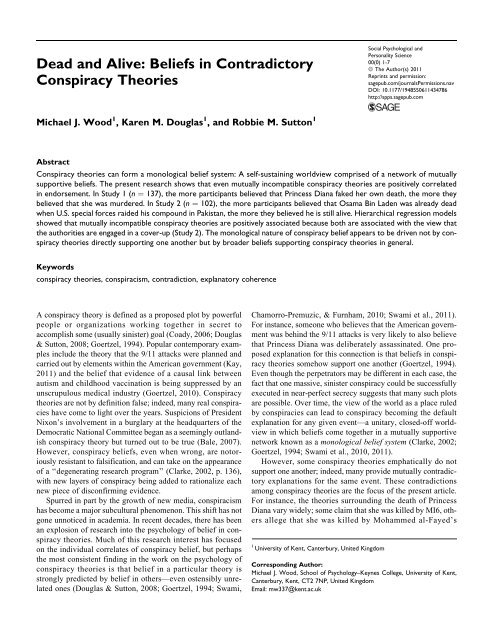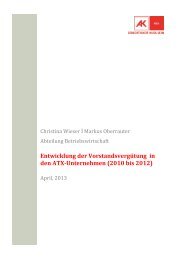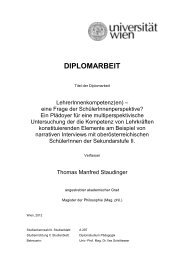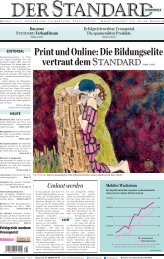Dead and Alive: Beliefs in Contradictory Conspiracy ... - Der Standard
Dead and Alive: Beliefs in Contradictory Conspiracy ... - Der Standard
Dead and Alive: Beliefs in Contradictory Conspiracy ... - Der Standard
Create successful ePaper yourself
Turn your PDF publications into a flip-book with our unique Google optimized e-Paper software.
<strong>Dead</strong> <strong>and</strong> <strong>Alive</strong>: <strong>Beliefs</strong> <strong>in</strong> <strong>Contradictory</strong><br />
<strong>Conspiracy</strong> Theories<br />
Social Psychological <strong>and</strong><br />
Personality Science<br />
00(0) 1-7<br />
ª The Author(s) 2011<br />
Repr<strong>in</strong>ts <strong>and</strong> permission:<br />
sagepub.com/journalsPermissions.nav<br />
DOI: 10.1177/1948550611434786<br />
http://spps.sagepub.com<br />
Michael J. Wood 1 , Karen M. Douglas 1 , <strong>and</strong> Robbie M. Sutton 1<br />
Abstract<br />
<strong>Conspiracy</strong> theories can form a monological belief system: A self-susta<strong>in</strong><strong>in</strong>g worldview comprised of a network of mutually<br />
supportive beliefs. The present research shows that even mutually <strong>in</strong>compatible conspiracy theories are positively correlated<br />
<strong>in</strong> endorsement. In Study 1 (n ¼ 137), the more participants believed that Pr<strong>in</strong>cess Diana faked her own death, the more they<br />
believed that she was murdered. In Study 2 (n ¼ 102), the more participants believed that Osama B<strong>in</strong> Laden was already dead<br />
when U.S. special forces raided his compound <strong>in</strong> Pakistan, the more they believed he is still alive. Hierarchical regression models<br />
showed that mutually <strong>in</strong>compatible conspiracy theories are positively associated because both are associated with the view that<br />
the authorities are engaged <strong>in</strong> a cover-up (Study 2). The monological nature of conspiracy belief appears to be driven not by conspiracy<br />
theories directly support<strong>in</strong>g one another but by broader beliefs support<strong>in</strong>g conspiracy theories <strong>in</strong> general.<br />
Keywords<br />
conspiracy theories, conspiracism, contradiction, explanatory coherence<br />
A conspiracy theory is def<strong>in</strong>ed as a proposed plot by powerful<br />
people or organizations work<strong>in</strong>g together <strong>in</strong> secret to<br />
accomplish some (usually s<strong>in</strong>ister) goal (Coady, 2006; Douglas<br />
& Sutton, 2008; Goertzel, 1994). Popular contemporary examples<br />
<strong>in</strong>clude the theory that the 9/11 attacks were planned <strong>and</strong><br />
carried out by elements with<strong>in</strong> the American government (Kay,<br />
2011) <strong>and</strong> the belief that evidence of a causal l<strong>in</strong>k between<br />
autism <strong>and</strong> childhood vacc<strong>in</strong>ation is be<strong>in</strong>g suppressed by an<br />
unscrupulous medical <strong>in</strong>dustry (Goertzel, 2010). <strong>Conspiracy</strong><br />
theories are not by def<strong>in</strong>ition false; <strong>in</strong>deed, many real conspiracies<br />
have come to light over the years. Suspicions of President<br />
Nixon’s <strong>in</strong>volvement <strong>in</strong> a burglary at the headquarters of the<br />
Democratic National Committee began as a seem<strong>in</strong>gly outl<strong>and</strong>ish<br />
conspiracy theory but turned out to be true (Bale, 2007).<br />
However, conspiracy beliefs, even when wrong, are notoriously<br />
resistant to falsification, <strong>and</strong> can take on the appearance<br />
of a ‘‘degenerat<strong>in</strong>g research program’’ (Clarke, 2002, p. 136),<br />
with new layers of conspiracy be<strong>in</strong>g added to rationalize each<br />
new piece of disconfirm<strong>in</strong>g evidence.<br />
Spurred <strong>in</strong> part by the growth of new media, conspiracism<br />
has become a major subcultural phenomenon. This shift has not<br />
gone unnoticed <strong>in</strong> academia. In recent decades, there has been<br />
an explosion of research <strong>in</strong>to the psychology of belief <strong>in</strong> conspiracy<br />
theories. Much of this research <strong>in</strong>terest has focused<br />
on the <strong>in</strong>dividual correlates of conspiracy belief, but perhaps<br />
the most consistent f<strong>in</strong>d<strong>in</strong>g <strong>in</strong> the work on the psychology of<br />
conspiracy theories is that belief <strong>in</strong> a particular theory is<br />
strongly predicted by belief <strong>in</strong> others—even ostensibly unrelated<br />
ones (Douglas & Sutton, 2008; Goertzel, 1994; Swami,<br />
Chamorro-Premuzic, & Furnham, 2010; Swami et al., 2011).<br />
For <strong>in</strong>stance, someone who believes that the American government<br />
was beh<strong>in</strong>d the 9/11 attacks is very likely to also believe<br />
that Pr<strong>in</strong>cess Diana was deliberately assass<strong>in</strong>ated. One proposed<br />
explanation for this connection is that beliefs <strong>in</strong> conspiracy<br />
theories somehow support one another (Goertzel, 1994).<br />
Even though the perpetrators may be different <strong>in</strong> each case, the<br />
fact that one massive, s<strong>in</strong>ister conspiracy could be successfully<br />
executed <strong>in</strong> near-perfect secrecy suggests that many such plots<br />
are possible. Over time, the view of the world as a place ruled<br />
by conspiracies can lead to conspiracy becom<strong>in</strong>g the default<br />
explanation for any given event—a unitary, closed-off worldview<br />
<strong>in</strong> which beliefs come together <strong>in</strong> a mutually supportive<br />
network known as a monological belief system (Clarke, 2002;<br />
Goertzel, 1994; Swami et al., 2010, 2011).<br />
However, some conspiracy theories emphatically do not<br />
support one another; <strong>in</strong>deed, many provide mutually contradictory<br />
explanations for the same event. These contradictions<br />
among conspiracy theories are the focus of the present article.<br />
For <strong>in</strong>stance, the theories surround<strong>in</strong>g the death of Pr<strong>in</strong>cess<br />
Diana vary widely; some claim that she was killed by MI6, others<br />
allege that she was killed by Mohammed al-Fayed’s<br />
1 University of Kent, Canterbury, United K<strong>in</strong>gdom<br />
Correspond<strong>in</strong>g Author:<br />
Michael J. Wood, School of Psychology–Keynes College, University of Kent,<br />
Canterbury, Kent, CT2 7NP, United K<strong>in</strong>gdom<br />
Email: mw337@kent.ac.uk
2 Social Psychological <strong>and</strong> Personality Science 00(0)<br />
bus<strong>in</strong>ess enemies, still others that she faked her own death.<br />
How does a conspiracy-believ<strong>in</strong>g observer reconcile the presence<br />
of these compet<strong>in</strong>g, mutually contradictory accounts? If<br />
beliefs <strong>in</strong> conspiracy theories are correlated with one another<br />
because the theories are <strong>in</strong> direct agreement, one would not<br />
expect reliable correlations between beliefs <strong>in</strong> theories that<br />
are mutually exclusive.<br />
In the present research, we seek to determ<strong>in</strong>e whether the<br />
coherence of the conspiracist belief system is driven not by<br />
direct relationships among <strong>in</strong>dividual theories, but by agreement<br />
between <strong>in</strong>dividual theories <strong>and</strong> higher-order beliefs<br />
about the world. For <strong>in</strong>stance, the idea that authorities are<br />
engaged <strong>in</strong> motivated deception of the public would be a cornerstone<br />
of conspiracist th<strong>in</strong>k<strong>in</strong>g due to its centrality <strong>in</strong> conspiracy<br />
theories. Someone who believes <strong>in</strong> a significant number of<br />
conspiracy theories would naturally beg<strong>in</strong> to see authorities as<br />
fundamentally deceptive, <strong>and</strong> new conspiracy theories would<br />
seem more plausible <strong>in</strong> light of that belief (Read, Snow, &<br />
Simon, 2003; Simon, Snow, & Read, 2004). Indeed, the two<br />
conspiracy theories mentioned above—an autism/vacc<strong>in</strong>e<br />
connection <strong>and</strong> 9/11 as an <strong>in</strong>side job—both revolve around<br />
that central proposition. Likewise, whether one believes that<br />
Pr<strong>in</strong>cess Diana was killed by MI6 or Mohammed Al-Fayed’s<br />
bus<strong>in</strong>ess enemies, belief <strong>in</strong> a cover-up would support (<strong>and</strong> be<br />
supported by) both theories. In spite of that, the two theories<br />
contradict each other. Would it be possible for their contradiction<br />
to be overruled by their coherence with a broader conspiracist<br />
worldview, such that they display a positive<br />
correlation <strong>in</strong> endorsement?<br />
Some literature on stereotyp<strong>in</strong>g suggests that coherence with<br />
strongly held worldviews may well be sufficient to overwhelm<br />
contradictions between <strong>in</strong>dividual beliefs. Adorno, Frenkel-<br />
Brunswik, Lev<strong>in</strong>son, & Sanford (1950) found strong positive<br />
correlations <strong>in</strong> endorsement between contradictory negative<br />
stereotypes of Jews, such that highly prejudiced participants<br />
found them to be both too isolated from the rest of society <strong>and</strong><br />
too eager to participate <strong>in</strong> it. Adorno proposed that this paradoxical<br />
perception has its roots <strong>in</strong> ‘‘a relatively bl<strong>in</strong>d hostility which<br />
is reflected <strong>in</strong> the stereotypy, self-contradiction, <strong>and</strong> destructiveness’’<br />
of anti-Jewish stereotyp<strong>in</strong>g (p. 76). In spite of their contradictory<br />
nature, both stereotypes drew enough credibility from<br />
their one common element—a negative perception of Jewish<br />
people—to end up with a strong positive association. The same<br />
may well be true of contradictory conspiracy theories; conspiracy<br />
advocates’ distrust of official narratives may be so strong<br />
that many alternative theories are simultaneously endorsed <strong>in</strong><br />
spite of any contradictions between them.<br />
The phenomenon of global coherence overrul<strong>in</strong>g local<br />
contradictions is perhaps best understood <strong>in</strong> the context of<br />
Thagard’s (1989) explanatory coherence model (ECHO) of<br />
social <strong>in</strong>ference. Explanatory coherence theory characterizes<br />
explanations <strong>and</strong> pieces of evidence about actors <strong>and</strong> events<br />
as either coherent or <strong>in</strong>coherent with one another. These elements<br />
are represented by nodes <strong>in</strong> a connectionist network.<br />
Activation flows from evidence nodes <strong>and</strong> higher-order knowledge<br />
structures (Read, 1987) to the various explanations, which<br />
<strong>in</strong> turn excite or <strong>in</strong>hibit one another depend<strong>in</strong>g on whether they<br />
are mutually coherent or contradictory. This process of excitation<br />
<strong>and</strong> <strong>in</strong>hibition cont<strong>in</strong>ues until the system reaches a stable<br />
equilibrium, at which po<strong>in</strong>t the highly activated explanations<br />
are accepted <strong>and</strong> those with little activation are discarded. Activation<br />
has been shown to flow the other way, as well: Not only<br />
do evidence <strong>and</strong> higher-order knowledge structures change<br />
one’s perception of explanations, emerg<strong>in</strong>g conclusions <strong>in</strong> the<br />
network also change perceptions of evidence <strong>and</strong> alter broad<br />
worldviews (Read et al., 2003; Read & Miller, 1993).<br />
For <strong>in</strong>stance, imag<strong>in</strong>e that someone is heavily <strong>in</strong>vested <strong>in</strong><br />
conspiracism <strong>and</strong> strongly believes <strong>in</strong> a wide variety of different<br />
conspiracy theories. A view of authority as fundamentally<br />
deceptive is coherent with all of these theories, <strong>and</strong> as such<br />
draws activation from them until it becomes a strongly held<br />
belief <strong>in</strong> itself. When a novel conspiracy theory is presented,<br />
it immediately seems more credible because it agrees with this<br />
now strongly held view <strong>and</strong> disagrees with the officially<br />
endorsed narrative. Such higher-order beliefs may be so<br />
strongly held that any conspiracy theory that st<strong>and</strong>s <strong>in</strong> opposition<br />
to the official narrative will ga<strong>in</strong> some degree of endorsement<br />
from someone who holds a conspiracist worldview, even<br />
if it directly contradicts other conspiracy theories that they<br />
also f<strong>in</strong>d credible. In other words, a natural consequence of<br />
the explanatory coherence approach to social explanation is<br />
an <strong>in</strong>stantiation of the pr<strong>in</strong>ciple ‘‘the enemy of my enemy is<br />
my friend.’’<br />
Indeed, this is a pr<strong>in</strong>ciple found explicitly <strong>in</strong> Heider’s (1958)<br />
theory of psychological balance, which shares a considerable<br />
common ground with explanatory coherence. In balance theory,<br />
perceptions of an object or social actor are affected by its<br />
relationship with other actors about which op<strong>in</strong>ions already<br />
exist. For <strong>in</strong>stance, people’s evaluations of a novel product<br />
endorsed by a known celebrity are more positive if they view<br />
the celebrity positively, or more negative if their views of the<br />
celebrity are negative. In the case of conspiracy theories, we<br />
propose that a similar mechanism is at work: Officials are seen<br />
as deceptive, perhaps even actively malevolent, so any explanation<br />
that they endorse is at a disadvantage, while alternative<br />
explanations are more credible from the start. Explanatory<br />
coherence has been shown to naturally <strong>in</strong>stantiate many of the<br />
Gestalt pr<strong>in</strong>ciples on which balance theory is based (Read et al.,<br />
2003), <strong>and</strong> others have noted the applicability of balance theory<br />
to the study of conspiracy belief, such as Inglehart (1987).<br />
Thus, we predict that for someone with a conspiracist worldview,<br />
nearly any theory that assumes deception by officialdom<br />
<strong>in</strong> its explanation for a world event <strong>and</strong> st<strong>and</strong>s <strong>in</strong> opposition to<br />
the ‘‘ma<strong>in</strong>stream’’ account will garner some agreement. This<br />
relationship may hold even to the po<strong>in</strong>t that people who believe<br />
<strong>in</strong> a world governed by conspiracy are likely to endorse contradictory<br />
conspiracy theories about the same topic. Just as Adornoet<br />
et al. (1950) found positive correlations <strong>in</strong> endorsement of<br />
contradictory stereotypes, we expect to see positive relationships<br />
between endorsement of contradictory conspiracy theories<br />
about the same event. For example, the more that<br />
participants believe that a person at the center of a death-
Wood et al. 3<br />
Table 1. Correlations Between Endorsement of Pr<strong>in</strong>cess Diana <strong>Conspiracy</strong> Theories <strong>in</strong> Study 1<br />
Official MI6<br />
Campaign to<br />
Kill Diana<br />
Dodi <strong>and</strong> Diana<br />
Killed by Al-Fayeds’<br />
Bus<strong>in</strong>ess Enemies<br />
Diana Had to Die<br />
Prevent Her From<br />
Marry<strong>in</strong>g an Arab<br />
Diana Faked<br />
Her Own Death<br />
Diana killed by rogue cell of British Intelligence .749 *** .614*** .670*** 0.15y<br />
Official MI6 campaign to kill Diana 1 .660*** .622*** .206*<br />
Dodi <strong>and</strong> Diana killed by Al-Fayeds’ bus<strong>in</strong>ess enemies 1 .607*** .253***<br />
Diana had to die to prevent her from marry<strong>in</strong>g an Arab 1 .242**<br />
Note. Correlations between mutually contradictory items are bolded. All correlation coefficients are Pearson r.<br />
***p < .001. **p < .01. *p < .05. Italics <strong>in</strong>dicate p < .10.<br />
related conspiracy theory, such as Pr<strong>in</strong>cess Diana or Osama B<strong>in</strong><br />
Laden, is still alive, the more they also tend to believe that the<br />
same person was killed, so long as the alleged manner of death<br />
<strong>in</strong>volves deception by officialdom.<br />
Study 1<br />
We first elected to exam<strong>in</strong>e the relationship between contradictory<br />
conspiracy theories regard<strong>in</strong>g the same event by ask<strong>in</strong>g<br />
about several rival accounts of Pr<strong>in</strong>cess Diana’s death.<br />
Method<br />
Participants. One hundred <strong>and</strong> thirty-seven undergraduate<br />
psychology students (83% female, mean age 20.4) were<br />
recruited from a second-year research methods class at a<br />
British university. Participation was voluntary <strong>and</strong> no compensation<br />
was given.<br />
Materials <strong>and</strong> procedure. For the purposes of the present<br />
study, we used the conspiracy theory belief scale used by<br />
Douglas <strong>and</strong> Sutton (2011). The questionnaire was 17 items<br />
long <strong>and</strong> used a 7-po<strong>in</strong>t Likert-type scale (1 ¼ strongly disagree,7¼<br />
strongly agree) to ascerta<strong>in</strong> participants’ agreement<br />
with a variety of different conspiracy theories. These <strong>in</strong>cluded<br />
9/11 as an <strong>in</strong>side job, global warm<strong>in</strong>g as a hoax by scientists <strong>and</strong><br />
politicians, <strong>and</strong> the idea of a fake moon l<strong>and</strong><strong>in</strong>g. Crucially, there<br />
were 5 items regard<strong>in</strong>g the death of Pr<strong>in</strong>cess Diana (Douglas<br />
& Sutton, 2008, 2011; a ¼ .83):<br />
1. One or more rogue ‘‘cells’’ <strong>in</strong> the British secret service<br />
constructed <strong>and</strong> carried out a plot to kill Diana.<br />
2. There was an official campaign by MI6 to assass<strong>in</strong>ate<br />
Diana, sanctioned by elements of the establishment.<br />
3. Diana faked her own death so that she <strong>and</strong> Dodi could<br />
retreat <strong>in</strong>to isolation.<br />
4. Bus<strong>in</strong>ess enemies of Dodi <strong>and</strong> his father Mohammed Al-<br />
Fayed assass<strong>in</strong>ated Dodi, with the death of Diana a<br />
cover-up for the operation.<br />
5. Diana had to be killed because the British government<br />
could not accept that the mother of the future k<strong>in</strong>g was<br />
<strong>in</strong>volved with a Muslim Arab.<br />
Not all of these items are mutually contradictory. Diana<br />
might conceivably have learned of a plot to kill her <strong>and</strong> faked<br />
her own death <strong>in</strong> response, so #3 <strong>and</strong> #2 do not necessarily<br />
contradict one another. #1 <strong>and</strong> #2 differ <strong>in</strong> the degree to which<br />
the operation to kill Diana was officially sanctioned, though not<br />
all participants would necessarily pick up on that difference.<br />
Likewise, #5 <strong>in</strong>dicates the existence of a plot to kill Diana but<br />
does not specify whether it was successful, so it does not explicitly<br />
contradict any of the other theories. However, there are<br />
some unambiguous contradictions. #1, #3, <strong>and</strong> #4 all propose<br />
different accounts of Diana’s apparent death: Either she was<br />
killed by a rogue cell of the British secret service (#1) or by<br />
bus<strong>in</strong>ess rivals of the Fayeds (#4), or she faked her own death<br />
(#3). These three theories are mutually <strong>in</strong>compatible <strong>and</strong> will<br />
be the focus of analysis <strong>in</strong> the present study.<br />
Results <strong>and</strong> Discussion<br />
We first performed an exploratory pr<strong>in</strong>cipal components analysis<br />
to <strong>in</strong>vestigate the factor structure of the scale. Based on a<br />
scree plot, we extracted two unrotated factors which together<br />
accounted for 46.9% of scale variance. All items had load<strong>in</strong>gs<br />
of at least .35 on the first factor <strong>in</strong> the unrotated solution, suggest<strong>in</strong>g<br />
that it represents generic conspiracy belief; the second<br />
factor drew load<strong>in</strong>gs only from the 5 items concern<strong>in</strong>g climate<br />
change conspiracy theories, <strong>and</strong> thus appears to be related to<br />
beliefs <strong>in</strong> these conspiracies <strong>in</strong> particular.<br />
In l<strong>in</strong>e with this factor structure, <strong>and</strong> with previous f<strong>in</strong>d<strong>in</strong>gs<br />
of high correlations among beliefs <strong>in</strong> different conspiracy theories,<br />
the scale showed reasonable reliability (a ¼ .78). Most of<br />
the questions were significantly correlated with one another<br />
despite cover<strong>in</strong>g different topics; for <strong>in</strong>stance, a belief that a<br />
rogue cell of MI6 was responsible for Diana’s death was correlated<br />
with belief <strong>in</strong> theories that HIV was created <strong>in</strong> a laboratory<br />
(r ¼ .39), that the moon l<strong>and</strong><strong>in</strong>g was a hoax (r ¼ .34),<br />
<strong>and</strong> that governments are cover<strong>in</strong>g up the existence of aliens<br />
(r ¼ .23; all ps < .01). In l<strong>in</strong>e with this general pattern, there<br />
was a network of significant positive relationships among<br />
the majority of the Pr<strong>in</strong>cess Diana conspiracy theories (see<br />
Table 1). People who believed that Diana faked her own death<br />
were marg<strong>in</strong>ally more likely to also believe that she was killed<br />
by a rogue cell of British Intelligence (r ¼ .15, p ¼ .075) <strong>and</strong><br />
significantly more likely to also believe that she was killed<br />
by bus<strong>in</strong>ess enemies of the Fayeds (r ¼ .25, p ¼ .003). Similarly,<br />
participants who found it likely that the Fayeds’ bus<strong>in</strong>ess
4 Social Psychological <strong>and</strong> Personality Science 00(0)<br />
rivals were responsible for the death of Diana were highly<br />
likely to also blame a rogue cell (r ¼ .61, p < .001).<br />
As can be seen <strong>in</strong> Table 1, the correlations <strong>in</strong> agreement with<br />
the idea that Diana faked her own death appear much lower<br />
than the rest, to the po<strong>in</strong>t that the only nonsignificant correlation<br />
<strong>in</strong>volves that theory. We believe this to be due to a floor<br />
effect rather than any sort of response to contradiction; endorsement<br />
of the faked-own-death theory was extremely low <strong>in</strong><br />
this sample, with a mean of only 1.52 on a 7-po<strong>in</strong>t scale. This<br />
level of endorsement was significantly lower than that of the<br />
other theories, for which agreement ranged from 2.51 (bus<strong>in</strong>ess<br />
rivals) to 2.98 (rogue cell; all ps < .001). As an alternative<br />
approach to the relationship between the faked-death<br />
theory <strong>and</strong> the rogue cell theory, we dichotomized responses<br />
to the faked-death item, compar<strong>in</strong>gthosewhogavethe<br />
lowest possible response with those who responded more<br />
positively. In accordance with the general pattern of results,<br />
participants who strongly disagreed with the faked-death<br />
theory showed a lower level of agreement with the rogue<br />
cell theory (M ¼ 2.75) than those who responded otherwise,<br />
M ¼ 3.47; t(134) ¼ 2.56, p ¼ .01.<br />
In l<strong>in</strong>e with our hypothesis, the results show mostly clear<br />
positive correlations <strong>in</strong> endorsement of contradictory conspiracy<br />
theories. Intuitively, this does not make sense. One would<br />
th<strong>in</strong>k that there ought to be a negative correlation between<br />
beliefs <strong>in</strong> contradictory accounts of events—the more one<br />
believes <strong>in</strong> a particular theory, the less likely rival theories will<br />
seem. One possible alternative explanation for these results is<br />
acquiescence bias: Participants may have simply replied <strong>in</strong> the<br />
same way to every question, result<strong>in</strong>g <strong>in</strong> positive correlations<br />
across the scale, regardless of the questions’ content. However,<br />
the scale <strong>in</strong>cluded a reverse-coded Diana conspiracy item<br />
which read, ‘‘The death of Pr<strong>in</strong>cess Diana was an accident.’’<br />
Contrary to the acquiescence hypothesis, this item was consistently<br />
negatively correlated with the rest of the scale, most<br />
notably r ¼ .75 with the rogue-cell item <strong>and</strong> r ¼ .65 with<br />
the MI6 item (both ps < .001).<br />
These results suggest that those who distrust the official<br />
story of Diana’s death do not tend to settle on a s<strong>in</strong>gle conspiracist<br />
account as the only acceptable explanation; rather, they<br />
simultaneously endorse several contradictory accounts. In<br />
Study 2, we set out to conceptually replicate these f<strong>in</strong>d<strong>in</strong>gs <strong>in</strong><br />
another sett<strong>in</strong>g <strong>and</strong> also to ask why mutually contradictory<br />
conspiracy theories are simultaneously endorsed.<br />
Study 2<br />
On May 2, 2011, it was reported <strong>in</strong> the news media that Osama<br />
b<strong>in</strong> Laden had been killed <strong>in</strong> an American raid on a compound<br />
<strong>in</strong> Abbottabad, Pakistan. <strong>Conspiracy</strong> theories alleg<strong>in</strong>g that b<strong>in</strong><br />
Laden had not actually been killed <strong>in</strong> the raid immediately<br />
started to propagate throughout the Internet <strong>and</strong> traditional<br />
media, mostly. Proponents claimed that their suspicions were<br />
aroused by several actions of the Obama adm<strong>in</strong>istration,<br />
<strong>in</strong>clud<strong>in</strong>g a refusal to release pictures of b<strong>in</strong> Laden’s body <strong>and</strong><br />
the decision to bury him at sea shortly after the raid.<br />
The conspiracy theories surround<strong>in</strong>g the death of Osama b<strong>in</strong><br />
Laden can be divided <strong>in</strong>to two major categories: those that propose<br />
he was already dead at the time of the raid, <strong>and</strong> those that<br />
propose he is still alive (K<strong>in</strong>gsley & Jones, 2011). The former<br />
seems to have currency among the 9/11 conspiracist Truth<br />
Movement; many ‘‘Truthers’’ allege that b<strong>in</strong> Laden died <strong>in</strong><br />
2000 or even earlier, <strong>and</strong> his video appearances s<strong>in</strong>ce then were<br />
<strong>in</strong> fact staged productions made with a body double. The latter<br />
theory varies; some people believe that he is still at large, while<br />
others th<strong>in</strong>k that he was captured alive <strong>and</strong> is be<strong>in</strong>g secretly<br />
held for <strong>in</strong>terrogation by the CIA. Naturally, these two theories<br />
are irreconcilable; b<strong>in</strong> Laden cannot be both alive <strong>and</strong> dead at<br />
the same time. However, as <strong>in</strong> Study 1, we predicted that belief<br />
<strong>in</strong> the two conspiracy theories would be positively correlated.<br />
Further, <strong>in</strong> order to test the idea that perceived deception by<br />
authorities underlies the positive correlation between contradictory<br />
conspiracy theories, we asked participants to what<br />
degree they found the American government’s actions surround<strong>in</strong>g<br />
the raid to be suspicious <strong>and</strong> <strong>in</strong>dicative of a coverup.<br />
This was <strong>in</strong>tended to operationalize the central pr<strong>in</strong>ciple<br />
of conspiracism outl<strong>in</strong>ed above: the idea that authorities are<br />
engaged <strong>in</strong> motivated deception. If belief <strong>in</strong> a cover-up is<br />
<strong>in</strong>deed responsible for the positive association between contradictory<br />
conspiracy theories, controll<strong>in</strong>g for it should cause the<br />
correlation between the contradictory theories to disappear.<br />
Method<br />
Participants. One hundred <strong>and</strong> two undergraduate students<br />
(58% female, mean age 21) at a British university were<br />
recruited to participate <strong>in</strong> the study between 1 <strong>and</strong> 6 weeks after<br />
the announcement of b<strong>in</strong> Laden’s death. In exchange for their<br />
participation, they received a r<strong>and</strong>omized prize of either a<br />
snack or a small monetary reward of GB£1.00 or 2.00<br />
(*US$1.50 or 3.00).<br />
Materials <strong>and</strong> procedure. Participants were directed to read a<br />
brief summary of the official story of Osama b<strong>in</strong> Laden’s death,<br />
<strong>in</strong>clud<strong>in</strong>g the details regard<strong>in</strong>g the refusal to release pictorial<br />
evidence <strong>and</strong> the burial at sea, followed by a short paragraph<br />
expla<strong>in</strong><strong>in</strong>g that some people doubt the official story. They were<br />
then asked about their op<strong>in</strong>ion of the official story, followed by<br />
three conspiracy items:<br />
1. Osama b<strong>in</strong> Laden was killed <strong>in</strong> the American raid.<br />
2. Osama b<strong>in</strong> Laden is still alive.<br />
3. When the raid took place, Osama b<strong>in</strong> Laden was already<br />
dead.<br />
4. The actions of the Obama adm<strong>in</strong>istration <strong>in</strong>dicate that they<br />
are hid<strong>in</strong>g some important or damag<strong>in</strong>g piece of <strong>in</strong>formation<br />
about the raid.<br />
Each of these statements was followed by a series of questions<br />
based on the composite endorsement measure used by<br />
Douglas <strong>and</strong> Sutton (2011). This asked participants to rate their<br />
agreement with each statement on a scale from 1 (strongly disagree)<br />
to6(strongly agree), as well as to what degree they
Wood et al. 5<br />
found the statements plausible, conv<strong>in</strong>c<strong>in</strong>g, worth consider<strong>in</strong>g,<br />
<strong>and</strong> coherent, aga<strong>in</strong> on a scale from 1 (notatall)to6(very<br />
much). These rat<strong>in</strong>gs were then averaged to obta<strong>in</strong> a composite<br />
measure of endorsement for each statement (a > .87 for each<br />
statement). While the orig<strong>in</strong>al measure used by Douglas <strong>and</strong><br />
Sutton also asked participants to judge the <strong>in</strong>terest<strong>in</strong>gness of<br />
each statement, there is no contradiction <strong>in</strong> f<strong>in</strong>d<strong>in</strong>g two rival<br />
theories equally <strong>in</strong>terest<strong>in</strong>g, so we excluded <strong>in</strong>terest<strong>in</strong>gness<br />
from the present study <strong>in</strong> order to avoid artificially <strong>in</strong>flat<strong>in</strong>g the<br />
relevant correlations.<br />
Results <strong>and</strong> Discussion<br />
The idea that b<strong>in</strong> Laden was killed <strong>in</strong> the raid enjoyed a high<br />
level of endorsement (M ¼ 5.00, SD ¼ 1.19), <strong>in</strong>dicat<strong>in</strong>g a fairly<br />
high level of trust <strong>in</strong> the official story, though participants on<br />
average found the Obama adm<strong>in</strong>istration’s actions to be suspicious<br />
(M ¼ 4.74, SD ¼ 1.41). Participants seemed less likely<br />
to endorse the idea that b<strong>in</strong> Laden is still alive (M ¼ 3.05,<br />
SD ¼ 1.39) or was already dead (M ¼ 3.19, SD ¼ 1.39). In a<br />
replication of our Study 1 result, a correlational analysis<br />
revealed a significant positive correlation between composite<br />
endorsement rat<strong>in</strong>gs of the two contradictory conspiracy theories,<br />
r ¼ .21, p ¼ .04.<br />
We next exam<strong>in</strong>ed the contribution of belief <strong>in</strong> a cover-up to<br />
the positive relationship between the two contradictory theories<br />
us<strong>in</strong>g a hierarchical multiple regression analysis. Endorsement<br />
of the cover-up item significantly predicted endorsement of<br />
the ‘‘b<strong>in</strong> Laden is still alive’’ theory, b ¼ .373, t(97) ¼ 4.04,<br />
p < .001 (the same was true of the already-dead theory,<br />
b ¼ .346, t(97) ¼ 3.63, p < .001). Add<strong>in</strong>g endorsement of the<br />
contradictory theory ‘‘b<strong>in</strong> Laden was already dead’’ to the<br />
regression equation, however, expla<strong>in</strong>ed no additional variance<br />
(DR 2 ¼ .006), <strong>and</strong> this theory was not itself a significant predictor,<br />
b ¼ .086, t(96)¼ 0.86, p ¼ .40. This <strong>in</strong>dicates that the correlation<br />
<strong>in</strong> endorsement of the two contradictory theories is<br />
expla<strong>in</strong>able entirely by their connection with belief <strong>in</strong> a deceptive<br />
cover-up by authority (see Figure 1). The degree to which<br />
someone believes <strong>in</strong> a cover-up helps determ<strong>in</strong>e their endorsement<br />
of the official story, <strong>and</strong> of both conspiracy theories as<br />
well. This result is <strong>in</strong> l<strong>in</strong>e with our predictions <strong>and</strong> supports the<br />
idea that conspiracy theories are def<strong>in</strong>ed not by adherence to a<br />
particular alternative account but by opposition to the official<br />
story <strong>and</strong> a belief that deception is tak<strong>in</strong>g place.<br />
General Discussion<br />
While it has been known for some time that belief <strong>in</strong> one conspiracy<br />
theory appears to be associated with belief <strong>in</strong> others,<br />
only now do we know that this can even apply to conspiracy<br />
theories that are mutually contradictory. This f<strong>in</strong>d<strong>in</strong>g supports<br />
our contention that the monological nature of conspiracism<br />
(Goertzel, 1994; Swami et al., 2010, 2011) is driven not by conspiracy<br />
theories directly support<strong>in</strong>g one another but by the<br />
coherence of each theory with higher-order beliefs that support<br />
the idea of conspiracy <strong>in</strong> general. As demonstrated <strong>in</strong> Study 2,<br />
Figure 1. Illustration of the observed correlations <strong>in</strong> endorsement of<br />
Study 2 items. The two conspiracy theories display a significant zeroorder<br />
correlation (above) but have no significant direct relationship<br />
when belief <strong>in</strong> a cover-up is taken <strong>in</strong>to account (below).<br />
perceived deception by authority is one such belief, <strong>and</strong> it is<br />
likely that there are many others as well. For those who hold<br />
such beliefs, the specifics of a conspiracy theory do not matter<br />
as much as the fact that it is a conspiracy theory at all.<br />
There are strong parallels between this conception of a monological<br />
belief system <strong>and</strong> Adorno et al.’s (1950) work on prejudice<br />
<strong>and</strong> authoritarianism. In an attempt to expla<strong>in</strong> the strong positive<br />
correlations between contradictory antisemitic beliefs, Adorno<br />
suggested that <strong>in</strong>compatibilities between beliefs at a local level<br />
are dwarfed by coherence with broader beliefs about the<br />
world—‘‘nuclear ideas’’ which ‘‘tend to ‘pull <strong>in</strong>’ numerous other<br />
op<strong>in</strong>ions <strong>and</strong> attitudes <strong>and</strong> thus to form a broad ideological system.’’<br />
(p. 92). Such a system ‘‘provides a rationale for any specific<br />
idea with<strong>in</strong> it <strong>and</strong> a basis for meet<strong>in</strong>g <strong>and</strong> assimilat<strong>in</strong>g new social<br />
conditions’’ (p. 93). Our f<strong>in</strong>d<strong>in</strong>gs support an equivalent explanation<br />
for beliefs <strong>in</strong> contradictory conspiracy theories, with a belief<br />
<strong>in</strong> deceptive officialdom as the nuclear idea <strong>in</strong> question.<br />
If Adorno’s explanation for contradictory antisemitic beliefs<br />
can <strong>in</strong>deed be applied to conspiracy theories, conspiracist<br />
beliefs might be most accurately viewed as not only monological<br />
but also ideological <strong>in</strong> nature. Just as an orthodox Marxist<br />
might <strong>in</strong>terpret major world events as aris<strong>in</strong>g <strong>in</strong>evitably from<br />
the forces of history, a conspiracist would see the same events<br />
as carefully orchestrated steps <strong>in</strong> a plot for global dom<strong>in</strong>ation.<br />
Conceptualiz<strong>in</strong>g conspiracism as a coherent ideology, rather<br />
than as a cluster of beliefs <strong>in</strong> <strong>in</strong>dividual theories, may be a fruitful<br />
approach <strong>in</strong> the future when exam<strong>in</strong><strong>in</strong>g its connection to<br />
ideologically relevant variables such as social dom<strong>in</strong>ance<br />
orientation <strong>and</strong> right-w<strong>in</strong>g authoritarianism.
6 Social Psychological <strong>and</strong> Personality Science 00(0)<br />
Although we have demonstrated the importance of a belief<br />
<strong>in</strong> deception by authority as an important antecedent of conspiracy<br />
belief <strong>and</strong> a partial explanation for correlations between<br />
contradictory theories, there are certa<strong>in</strong>ly other broad beliefs<br />
which could make a similar contribution. For <strong>in</strong>stance, conspiracy<br />
theories would seem much more plausible to those with a<br />
belief <strong>in</strong> the effectiveness of <strong>in</strong>timidation <strong>and</strong> bribery. In a<br />
more abstract sense, a belief <strong>in</strong> the essential malevolence of<br />
officialdom—or <strong>in</strong> the specific malevolence of a certa<strong>in</strong> powerful<br />
entity—would make many conspiracies seem more likely.<br />
The social element must not be neglected either; many conspiracy<br />
theories are associated with specific groups or even organized<br />
movements, such as the 9/11 Truth Movement. Clarke<br />
(2007) found a trend of <strong>in</strong>creas<strong>in</strong>g vagueness <strong>in</strong> these modern<br />
conspiracist communities, which he characterized as a reaction<br />
to the antagonistic atmosphere of Internet discourse. Our<br />
results suggest an alternative possibility: A genu<strong>in</strong>e uncerta<strong>in</strong>ty<br />
with<strong>in</strong> <strong>in</strong>dividuals regard<strong>in</strong>g the true nature of the conspiracy<br />
beh<strong>in</strong>d a particular event (beyond the fact that there was one),<br />
<strong>and</strong> a will<strong>in</strong>gness to consider <strong>and</strong> even endorse mutually contradictory<br />
accounts as long as they st<strong>and</strong> <strong>in</strong> opposition to the<br />
officially sanctioned narrative. There may also be an element<br />
of self-presentation <strong>and</strong> conflict avoidance <strong>in</strong> the vagueness<br />
observed by Clarke: If multiple contradictory theories are<br />
simultaneously believed by many <strong>in</strong> a conspiracist community,<br />
endors<strong>in</strong>g one <strong>in</strong> particular is tantamount to deny<strong>in</strong>g the others<br />
<strong>and</strong> may provoke a backlash. In any event, the development of<br />
conspiracy theories almost certa<strong>in</strong>ly owes a great deal to social<br />
engagement <strong>and</strong> discussion of alternative narratives, <strong>and</strong> the<br />
dynamics of conspiracist communities may be a fruitful avenue<br />
for future <strong>in</strong>vestigation with reference to previous work on<br />
op<strong>in</strong>ion-based groups (e.g., Musgrove & McGarty, 2008).<br />
Conspiracist belief systems may also be well captured by connectionist<br />
models of social <strong>in</strong>ference such as Thagard’s (1989)<br />
ECHO. ECHO has been shown to accurately predict the degree<br />
to which higher-order beliefs about social actors affect judgements<br />
of their actions as s<strong>in</strong>ister or <strong>in</strong>nocent, honest or deceptive<br />
(Read & Miller, 1993). However, there has been little or no<br />
<strong>in</strong>vestigation <strong>in</strong>to the ability of ECHO to model the <strong>in</strong>fluence<br />
of broad worldviews. Based on the present research, one would<br />
expect that when broad beliefs are relevant to the <strong>in</strong>terpretation<br />
of a particular situation, they serve as a constra<strong>in</strong>t on the conclusions<br />
that are likely to be drawn from it <strong>in</strong> the same way as specific<br />
beliefs about the actors <strong>and</strong> situations <strong>in</strong>volved. A<br />
conspiracist belief system consist<strong>in</strong>g of many such beliefs would<br />
<strong>in</strong>hibit the acceptance of official narratives but may not discrim<strong>in</strong>ate<br />
among several different conspiracy theories. Some might be<br />
discarded, but even contradictory theories might be simultaneously<br />
accepted. Almost any account of events which accords with<br />
the broader beliefs <strong>in</strong> question is likely to garner some endorsement<br />
by adherents of a conspiracist worldview. Modell<strong>in</strong>g such a<br />
network might provide an <strong>in</strong>structive <strong>in</strong>sight <strong>in</strong>to the processes<br />
underly<strong>in</strong>g the development of conspiracist beliefs, <strong>and</strong> of other<br />
beliefs <strong>in</strong>fluenced by superord<strong>in</strong>ate ideological considerations.<br />
It must be noted that not all conspiracy theories fall under<br />
the ‘‘deceptive officialdom’’ umbrella. Antisemitic conspiracy<br />
theories are a notable <strong>and</strong> historically important exception;<br />
<strong>in</strong>stead of alleg<strong>in</strong>g abuse of power by elites, historical theories<br />
of Jewish conspiracy usually detailed supposed attempts by a<br />
m<strong>in</strong>ority to seize power for themselves (Graumann, 1987). It<br />
would be <strong>in</strong>structive to exam<strong>in</strong>e whether beliefs <strong>in</strong> such conspiracies<br />
are correlated with belief <strong>in</strong> those that fit more<br />
closely <strong>in</strong>to the ‘‘deceptive officialdom’’ template, <strong>and</strong> if such<br />
relationships are mediated to the same degree by endorsement<br />
of that central belief.<br />
In any case, the evidence we have gathered <strong>in</strong> the present<br />
study supports the idea that conspiracism constitutes a monological<br />
belief system, draw<strong>in</strong>g its coherence from central beliefs<br />
such as the conviction that authorities <strong>and</strong> officials engage <strong>in</strong><br />
massive deception of the public to achieve their malevolent<br />
goals. Connectivity with this central idea lends support to any<br />
<strong>in</strong>dividual conspiracy theory, even to the po<strong>in</strong>t that mutually<br />
contradictory theories fail to show a negative correlation <strong>in</strong><br />
belief. Believ<strong>in</strong>g that Osama b<strong>in</strong> Laden is still alive is apparently<br />
no obstacle to believ<strong>in</strong>g that he has been dead for years.<br />
Declaration of Conflict of Interest<br />
The author(s) declared no potential conflicts of <strong>in</strong>terests with respect<br />
to the authorship <strong>and</strong>/or publication of this article.<br />
Fund<strong>in</strong>g<br />
The author(s) received no f<strong>in</strong>ancial support for the research, authorship,<br />
<strong>and</strong>/or publication of this article.<br />
References<br />
Adorno, T. W., Frenkel-Brunswik, E., Lev<strong>in</strong>son, D. J., & Sanford, R. N.<br />
(1950). The authoritarian personality. Oxford, Engl<strong>and</strong>: Harpers.<br />
Bale, J. M. (2007). Political paranoia v. political realism: On dist<strong>in</strong>guish<strong>in</strong>g<br />
between bogus conspiracy theories <strong>and</strong> genu<strong>in</strong>e conspiratorial<br />
politics. Patterns of Prejudice, 41, 45–60.<br />
Clarke, S. (2002). <strong>Conspiracy</strong> theories <strong>and</strong> conspiracy theoriz<strong>in</strong>g. Philosophy<br />
of the Social Sciences, 32, 131–150.<br />
Clarke, S. (2007). <strong>Conspiracy</strong> theories <strong>and</strong> the Internet: Controlled<br />
demolition <strong>and</strong> arrested development. Episteme: A Journal of<br />
Social Epistemology, 4, 167–180.<br />
Coady, D. (2006). <strong>Conspiracy</strong> theories: The philosophical debate.<br />
Aldershot: Ashgate.<br />
Douglas, K. M., & Sutton, R. M. (2008). The hidden impact of conspiracy<br />
theories: Perceived <strong>and</strong> actual <strong>in</strong>fluence of theories surround<strong>in</strong>g the<br />
death of Pr<strong>in</strong>cess Diana. Journal of Social Psychology, 148, 210–222.<br />
Douglas, K. M., & Sutton, R. M. (2011). Does it take one to know one?<br />
Endorsement of conspiracy theories is <strong>in</strong>fluenced by personal will<strong>in</strong>gness<br />
to conspire. British Journal of Social Psychology, 50,<br />
542–552.<br />
Goertzel, T. (1994). Belief <strong>in</strong> conspiracy theories. Political Psychology,<br />
15, 731–742.<br />
Goertzel, T. (2010). <strong>Conspiracy</strong> theories <strong>in</strong> science. EMBO Reports,<br />
11, 493–499.<br />
Graumann, C. F. (1987). <strong>Conspiracy</strong>: History <strong>and</strong> social psychology-a<br />
synopsis. In C. F. Graumann & S. Moscovici (Eds.), Chang<strong>in</strong>g<br />
conceptions of conspiracy (pp. 245–251). New York, NY:<br />
Spr<strong>in</strong>ger.
Wood et al. 7<br />
Grzesiak-Feldman, M., & Suszek, H. (2008). <strong>Conspiracy</strong> stereotyp<strong>in</strong>g<br />
<strong>and</strong> perceptions of group entitativity of Jews, Germans, Arabs <strong>and</strong><br />
homosexuals by polish students. Psychological Reports, 102,<br />
755–758.<br />
Inglehart, R. (1987). Extremist political positions <strong>and</strong> perceptions of<br />
conspiracy. In C. F. Graumann & S. Moscovici (Eds.) Chang<strong>in</strong>g<br />
conceptions of conspiracy (pp. 231–244). New York, NY: Spr<strong>in</strong>ger.<br />
Kay, J. (2011). Among the truthers: A journey through America’s conspiracist<br />
underground. New York, NY: HarperColl<strong>in</strong>s.<br />
K<strong>in</strong>gsley, P., & Jones,S. (2011, May 5). Osama b<strong>in</strong> Laden death: The conspiracy<br />
theories. The Guardian. Retrieved from http://www.guardian.<br />
co.uk/world/2011/may/05/osama-b<strong>in</strong>-laden-conspiracy-theories<br />
Musgrove, L., & McGarty, C. (2008). Op<strong>in</strong>ion-based group membership<br />
as a predictor of collective emotional responses <strong>and</strong> support<br />
for pro- <strong>and</strong> anti-war action. Social Psychology, 39, 37–47.<br />
Read, S. J. (1987). Construct<strong>in</strong>g causal scenarios: A knowledge structure<br />
approach to causal reason<strong>in</strong>g. Journal of Personality <strong>and</strong><br />
Social Psychology, 52, 288–302.<br />
Read, S. J., & Miller, L. C. (1993). Rapist or ‘‘regular guy’’: Explanatory<br />
coherence <strong>in</strong> the construction of mental models of others. Personality<br />
<strong>and</strong> Social Psychology Bullet<strong>in</strong>, 19, 526–540.<br />
Read, S. J., Snow, C. J., & Simon, D. (2003). Constra<strong>in</strong>t satisfaction<br />
processes <strong>in</strong> social reason<strong>in</strong>g. In the Proceed<strong>in</strong>gs of the Twenty-<br />
Fifth Annual Conference of the Cognitive Science Society.<br />
Simon, D., Snow, C. J., & Read, S. J. (2004). The redux of cognitive<br />
consistency theories: Evidence judgments by constra<strong>in</strong>t satisfaction.<br />
Journal of Personality <strong>and</strong> Social Psychology, 86, 814–837.<br />
Swami, V., Chamorro-Premuzic, T., & Furnham, A. (2010). Unanswered<br />
questions: A prelim<strong>in</strong>ary <strong>in</strong>vestigation of personality <strong>and</strong><br />
<strong>in</strong>dividual difference predictors of 9/11 conspiracist beliefs.<br />
Applied Cognitive Psychology, 24, 749–761.<br />
Swami, V., Coles, R., Stieger, S., Pietschnig, J., Furnham, A., Rehim,<br />
S., & Voracek, M. (2011). Conspiracist ideation <strong>in</strong> Brita<strong>in</strong> <strong>and</strong><br />
Austria: Evidence of a monological belief system <strong>and</strong> associations<br />
between <strong>in</strong>dividual psychological differences <strong>and</strong> real-world <strong>and</strong><br />
fictitious conspiracy theories. British Journal of Psychology,<br />
102, 443–463.<br />
Thagard, P. (1989). Explanatory coherence. Behavioral <strong>and</strong> Bra<strong>in</strong><br />
Sciences, 12, 435–502.<br />
Bios<br />
Michael J. Wood is a PhD c<strong>and</strong>idate at the University of Kent, United<br />
K<strong>in</strong>gdom. His research focuses on the psychology of conspiracy<br />
theories.<br />
Karen M. Douglas is a reader <strong>in</strong> psychology at the University of<br />
Kent, United K<strong>in</strong>gdom. She has published widely on topics such as<br />
language <strong>and</strong> stereotyp<strong>in</strong>g, persuasion, the psychology of the Internet,<br />
<strong>and</strong> the psychology of conspiracy theories.<br />
Robbie M. Sutton is a reader <strong>in</strong> psychology at the University of Kent,<br />
United K<strong>in</strong>gdom. His research <strong>in</strong>terests <strong>in</strong>clude the psychology of justice,<br />
gender, <strong>and</strong> <strong>in</strong>tergroup processes.
















